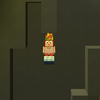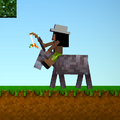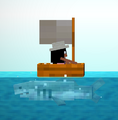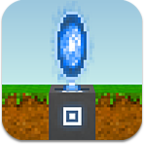Travel
A blockhead can change its location through various forms of travel depending on the terrain.
To make the selected blockhead travel, tap a location one or more block spaces away from its current position. An outline will appear at the new position and if the game can determine a path for the blockhead to take (a process which may cause gears to appear above the blockhead), it will begin traveling there. If no path is found, the outline will disappear. When no path is found, there is nothing displayed to indicate why. Sometimes a travel request has been rejected for what appears to be reasons of distance, but there have also been routes selected that are longer than necessary. Routing will not pass through areas that haven't been revealed or are completely unlit.
The game determines what route and methods of travel will be used, with the exception of riding or sailing which must be initiated by the player making a blockhead use the appropriate equipment. If a specific path is desired, it may be necessary to select intermediate points along that route.
While there is no complication to blockheads passing each other, they will tend to avoid standing in the same location.
If the display is automatically centered on a blockhead while it travels, the rest of the world will scroll past.
Types of Travel
Walking
Blockheads moving across horizontal spans of solid block tops that are no more than one block different in height travel in a stiff-legged gait that may be called alternately walking or running. This is the basic (and possibly preferred) method a blockhead uses.
There may be a slight increase in apparent speed if a blockhead is walking along a long series of one-block changes in height. This is most likely due to the horizontal and vertical speeds combining. Stairs along a blockhead's path will increase its walking speed.
The various forms of boots will improve walking speed, with the south pole boots of speed producing an easily seen increase.
Crawling
Crawling substitutes for walking when a blockhead must pass through a gap too short for it to travel upright. While a blockhead is only two blocks tall, when walking up or down one block heights it will need an additional open block (above if going up, adjacent if going down) to avoid crawling.
When crawling, a blockhead's body is horizontal while its legs and arms are extended down and moving stiffly. In this position, its hands and feet are "inside" the block below although its true appearance can be seen in the Character Status Icon.
Jumping
A blockhead can cross small gaps by jumping. The maximum distance jumped is one block, and may be vertical, horizontal, or both.
Horizontal jumps while walking seem just slightly slower than walking. Placing stairs in the space immediately above a horizontal gap eliminates the need for a jump.
Vertical jumps will allow a blockhead to reach a block above its head.
Climbing

If a blockhead is traveling along the bottom surfaces of solid blocks or the vertical sides of two or more, or if using a ladder, it will climb. Blockheads are extremely capable climbers, never losing their grip and always finding a hand-hold.
When crossing a vertical rise (or drop) of two or more blocks, a blockhead will make a one-block jump onto it and climb until it can safely make a one-block jump off. This means that for two-block climbs a blockhead will simply jump twice, clinging to a block between them. For greater distances, a blockhead will make motions very similar to crawling but either up or down along the block sides.
The underside of blocks are no impediment to a blockhead. When crossing a ceiling, a blockhead will hang from its hands, slowly reaching forward before changing its grip and reaching with the other hand. Single block changes in height cause a blockhead to lever itself closer using both arms before jumping slightly and grabbing the next surface with both hands. This is also how it transitions between a vertical climb and a ceiling climb.
In some unusual situations, a blockhead can appear to defy gravity momentarily, either levitating as it looks out of the device's screen or climbing over an invisible block. This is due to glitches in how a blockhead is displayed as it transitions between climbing positions and directions.
A blockhead climbing a ladder or tree will face the item and travel up, down, or sideways as appropriate, its arms and legs moving similarly to crawling. Ladder or tree climbing is about as fast as walking for vertical movement, but much slower horizontally.
If the item being climbed is removed (such as by mining or a tree dying), the affected blockhead will attempt to jump to an adjacent stable block. If none are available, the blockhead will fall, suffering appropriate damage on impact.
Elevator
Elevator shafts may substitute for ladders whether powered or not, but when powered by an active electric elevator motor at the top or bottom of a continuous column of shafts they may be used by blockheads for much faster vertical travel along the shafts.
Swimming
Swimming is the default way a blockhead moves through water. It is not as fast as sailing a boat, but will allow the blockhead to pick up items floating on the surface or otherwise in the water.
A swimming blockhead can use tools on blocks, creatures, or plants as well as place blocks or other items.
If a blockhead's head is not in contact with air (either from being completely underwater or between water and a solid block), it will begin running out of air.
Falling
The game will not deliberately make a blockhead fall more than a short, easily survived distance. It is most common when a blockhead is descending no more than a few block's distance, say from a ceiling to a floor, tree to ground, or ceiling to the top of a ladder. These falls cause no damage.
But if properly arranged, a blockhead will sustain injuries from a fall of six or more blocks. This should require some deliberate (if inattentive) effort by a player or extremely unusual circumstances such as:
- Being on a despawning tree limb over a significant drop.
- Setting fire to the tree or ladder a blockhead is standing on.
- Removing a jetpack, mid-flight.
- Removing a block when no other blocks are within reach.
Falling any distance into water causes no injury.
Previous version of the game allowed a player to remove the ladder a blockhead was hanging from, thus causing it to fall.
A falling blockhead can catch itself on ladders or adjacent solid blocks, if falling at a slow enough speed. This often includes a slight up-down motion as the blockhead "recovers" from the fall and stabilizes itself.
Riding
There are three ways for a blockhead to ride in The Blockheads. All use a similar method of player control, the tilting of the play device in the direction desired. Except for rails, when not tilted the blockhead and its ride will face the player. While riding, the blockhead remains centered on the display.
A riding blockhead cannot use tools or otherwise act on blocks, creatures, or plants, although it will tend to pick up loose items it passes.
Donkey
- See also: Donkey
A blockhead using a carrot on a stick on a donkey will cause it to ride the donkey. This is usually faster than walking. When riding a donkey, the blockhead will collect items up to three block high but will tend to miss those directly on the ground.
Sailing
- See also: Boat
A blockhead can choose to "Embark" on a boat to go sailing across the water. This is much faster and safer than swimming. A boating blockhead will also tend to pick up floating items it passes. (This didn't happen in older versions of the game, forcing a blockhead to get out of the boat before retrieving them.)
Rail
- See also: Rail Handcar, Steam Locomotive, and Passenger Car
A blockhead can ride three different ways on rails: with a rail handcar, on a steam locomotive, or in a passenger car. Without one of these vehicles, rails are mostly ignored.
Flying
- See also: Jetpack
Introduced in version 1.6, a jetpack allows the using blockhead to travel through the air without support from blocks, ladders, or stairs. This allows the exploration of the sky, the discovery of floating islands and their gem trees, and construction without the need for supporting surfaces or ladders.
Teleporting
- See also: Teleport Here
By expending time crystals, a blockhead can instantly be moved to a selected portal. The farther from the portal a blockhead is, the more it will cost to teleport the blockhead there.
Gallery
-
A blockhead riding a donkey
-
A blockhead rides a boat over a shark


